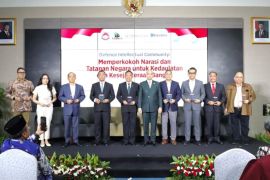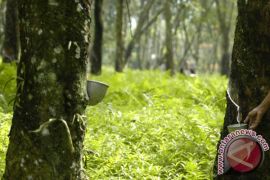Based on data from the South Sumatra Plantation Office as of April 16, 2019, the price of 100 percent dry rubber was Rp18,708 / kg, 70 percent dry was Rp13,096 / kg, 60 percent dry rubber was Rp11,225 / kg, 50 percent dry was Rp9,345 kg and 40 percent dry rubber was Rp7,483 / kg.
The price of rubber at the level of the South Sumatra farmer is around Rp7,483 / kg because most farmers in the area produce rubber latex products with a dry content of 40 percent.
Head of Hamlet III of Sigam Kayal Sari Village, Gelumbang District, Muaraenim District, South Sumatra, Sahbihis said that the drop in rubber prices in the past five years had changed the lives of rubber plantation communities in his village.
Most rubber planters do not care about their land because the costs incurred are not proportional to the income. "Not just for rejuvenation, fertilization alone has not been done for years by farmers," Sahbihis said.
Since prices have fallen due to the impact of the weakening global economy, the income of the rubber planters has dropped dramatically. In just one hectare, farmers make only Rp700,000-Rp800,000 per month, while most farmers in the village only have 1-2 hectares of land.
As a result, some began to leave their rubber plantations or no longer tapped sap. In fact, some farmers choose to cut down their rubber trees to be replaced with other crops such as vegetables.
This decision was also influenced by the fact that most of the rubber plantations in the village are over 25 years old, which means it is time for rejuvenation as the productivity of sap has decreased.
"There are also those who sell their total land at a low price of only Rp30 million per hectare, and switch jobs, for example, become laborers in the city as they have no other choice," he said.
Surono, a rubber planter in the village, said that a number of rubber farmers now switch some of their plantation into vegetable gardens, as he did.
He used a hectare of his rubber plantation to plant vegetables such as oyong and chili with an initial capital of 5 million rupiah to buy seeds and other requirements.
From the oyong harvest, Surono received a net profit of 3.5 million rupiah per harvest in three weeks. Because of this, he can survive amid the falling price of rubber.
When asked why he was not converting the entire existing land into a vegetable garden, Surono said he was still optimistic that rubber prices would improve.
Describing it as a sad situation, the middle-aged man said he had previously followed the government's suggestion to plant rubber in the early 1990s. "In the past, the government told us to plant rubber, and we did. However, when the price fell, the government could not do anything," he said.
Complex problem
The Ministry of Industry's Director of Forest Products and Plantation Industries Edy Sutopo said that the issue of rubber plantations in Indonesia is very complex.
Some real issues such as low quality, long links, and international market competition have yet to be resolved.
Moreover, the entry of two new countries namely Vietnam and Cambodia, in addition to the cooperation of three countries—Indonesia, Thailand and Malaysia—to reduce international market supply has been in vain for the past few years..
He said that currently, the government is encouraging the absorption of rubber in its own country such as for the mixture of asphalt manufacture, which has so far been 12 percent of its content.
The use of rubber in the asphalt mixture for road construction along the 465 kilometers has been carried out in Musi Banyuasin District, South Sumatra, which is capable of absorbing 8.49 tons of natural rubber produced by community plantations in 2019 or an increase compared to the previous 1.2 tons per year.
"Although the absorption is still small, this is a new demand. There is hope," he said.
The drop in rubber prices at the farm level since 2013 angered thousands of farmers in South Sumatra because the price of only Rp6,000-Rp7,000 per kilogram was far from the ideal above Rp12,000 per kilogram.
The decline in the price of people's rubber is very dependent on the international market because most of the raw material is exported.
According to him, there is one thing that deserves attention regarding this international market because the 2.2 million world rubber stocks are actually in accordance with global needs.
The government has seen the situation over five years as rather strange because the price of car tires (the highest natural rubber absorbent product) has remained stable in the midst of the situation of falling raw material prices.
"This condition needs to be resolved diplomatically, it is already related to international issues; why is the upstream side of the margin depressed compared to the downstream side?" he asked.
While it was related to this never-ending problem, the Governor of South Sumatra, Herman Deru, said the provincial government was trying to improve the quality of the rubber latex of farmers by providing training so that prices could be better as in Jambi and North Sumatra.
Then, the provincial government improves the farmers' rubber auction system by striving to have a rubber auction system in each district. Currently, there are 177 Bokar Processing and Marketing Units (UPPBs) in 14 districts / cities in South Sumatra.
Rudi Arpian, Head of Processing and Product Marketing at the Plantation Office of South Sumatra Province, said that the auction had only been attended by certain entrepreneurs, so that the winners were arranged alternately.
To that end, the South Sumatra Provincial Government has opened a path to other entrepreneurs to enter this rubber auction so that prices at the farm level will be lifted.
"The auction system is not good. The auction should be conducted on a large scale in one day, with the same price so that buyers go directly to farmers. This is what we encourage," he said.
In addition, the governor also sought to build a car tire factory so that absorption was carried out within his own country.
The presence of this tire factory is expected to be a solution to help thousands of rubber planters who utilize 1.3 million hectares of land with a production of around 1 million tons per year in the South Sumatra region.
Editor: Bambang Purwanto
Copyright © ANTARA 2019











